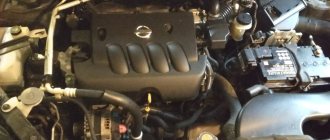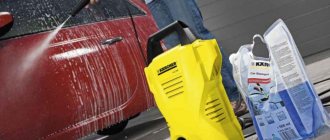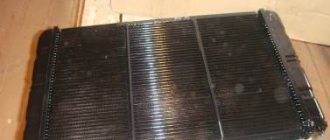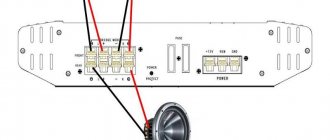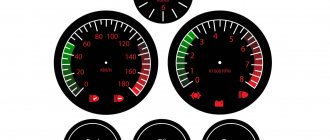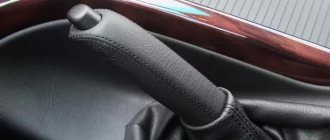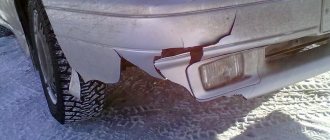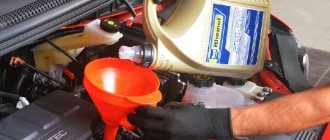To be or not to be?
The answer to the question “is it possible to wash a car engine” has not caused heated debate for a long time. It is not only possible to wash the engine, but also necessary. There are a number of simple reasons for this:
- heat transfer improves. The adhesion of a thick layer of mud deposits prevents the heat exchange of the engine block and cylinder head with the atmosphere. If in winter this cannot affect the operation of the engine, then in hot weather the accumulation of dirt can lead to overheating. This is especially dangerous when driving in a traffic jam, when there is no airflow to the radiators, and the air conditioning system is turned on in the car. A dirty engine will only make the situation worse if the radiator is clogged. In some cars, when washing the engine compartment, you have access to the radiator. But for a guaranteed effect, the cooler must be removed and then washed on both sides with a Karcher;
- reduction of fire hazard. Leaks in the connections of the cylinder head, cylinder head, and oil pan, which is quite normal for many used cars, leads to the appearance of oil deposits. In the event of a fire in the engine compartment, the oil helps the flame spread.
You can wash the internal combustion engine not only for aesthetic pleasure, but also to improve the quality of repairs. After washing the engine it is always easier to identify leaking seals. Due to its composition, the oil quickly occupies a significant area around the fogging perimeter. Therefore, over time, it is more difficult to determine the source of the problem. If you are repairing your car yourself, then it will be superfluous to talk about the inconvenience that crumbling dirt causes. The ingress of dirt can affect the operation of some mechanisms and the quality of the connection of parts.
Is it possible to “kill” a motor by washing?
Consequences of violation of internal combustion engine rinsing technology:
- the car does not start;
- the engine starts, but then immediately stalls;
- unstable operation (motor troubles);
- Certain electrical appliances do not work;
- lack of traction, dips when pressing the gas.
As we can see, the main catalyst for trouble is electronics, since mechanical components are reliably protected from moisture. The meanness also lies in the fact that certain symptoms may appear only after some time (oxidation of contacts). And if spark plug wells and distributor contacts flooded with water can be dried, thereby eliminating most of the problems in the operation of the internal combustion engine, then failure of the ECU is a harbinger of large investments. If there are important control units, and especially ECUs, in the engine compartment of your car, the car should be prepared before washing.
Using high pressure washers
The design of the engine compartment of each car requires a certain level of protection of important components and assemblies from moisture. But since under normal operating conditions the amount of moisture is very small, washing the engine with a Karcher can really harm the car.
Using a jet of water under high pressure leads to water “clogging” even the most secluded corners of the engine compartment. As a result, water can leak to the contacts of electrical appliances, actuators, and sensors of the engine power system. But most of all, you should be wary of moisture getting into the ECU, which can burn it, or into the fuse box, some of which are located in the engine compartment in many cars. This is why you need to wash your car engine correctly.
Arguments against"
- After such a Karcher wash, the car often does not start;
- electrical connectors protected by rubber seals do not guarantee complete tightness against exposure to high-pressure water from a washing machine;
- the engine control unit located in the engine compartment may fail partially or completely;
- failure of various expensive electrical equipment;
- pouring water onto spark plugs and spark plug wells;
- high probability of short circuit;
- engine water hammer due to water entering the cylinders through the ventilation passages or inlet pipe;
- accelerated corrosion of joints and welds in the engine compartment;
- rubber and plastic sealing joints and insulation become unusable after contact with aggressive detergents;
Next, we intend to substantively understand whose side the truth will be on. Let's turn to the most authoritative opinion.
Some useful tips - a life hack for a car wash
To ensure that washing your car with a Karcher at home always gives the same results as professional car washes, follow the following recommendations:
- do not wash your car in the sun, as shampoo and other chemicals will dry quickly without having time to react with dirt;
- For the same reason, do not start washing the car immediately after the trip - let it cool. If this is not possible, start working with the doors, then move on to the wings and roof, and only lastly apply foam to the hood so that it has time to cool a little;
- if the car body is wet after rain, let it dry;
- You shouldn’t skimp on car chemicals, since cheap shampoos are unlikely to allow you to achieve good results;
- Do not use regular shampoos to wash your car - high-pressure washers require special car chemicals.
That, in fact, is all you need to know to properly wash your car with a mini car wash or Karcher. The only thing, do not forget about safety - active foam, when it gets on concrete, forms a slippery surface, so try to immediately wash it off from the area around the car. Also, make sure that the washer hoses are not lying around under your feet.
Is it necessary and possible to wash a car engine?
When operating a car, owners often think about washing the power unit, since over time it becomes covered with dust and oil sometimes gets on it, as a result of which the appearance of the unit becomes not very attractive. Since engine washing is a responsible process, all the nuances are worth considering in more detail.
Why wash
Despite the fact that there are many supporters and opponents of engine washing, it is necessary to highlight the following negative aspects that arise due to contamination of the unit:
- deterioration of heat transfer. Due to the thick layer of dirt and dust, the engine housing is less cooled by the cooling fan;
- reduction in power. Due to poor heat transfer, motor power is reduced;
- increase in fuel consumption. A decrease in power is inextricably linked with an increase in fuel consumption. In addition, the service life of many engine components is reduced;
- increased fire hazard. The accumulation of contaminants on the outer surface of the power unit can cause spontaneous combustion, since dust and oil settle on the surface of the unit, which heats up during operation.
The listed problems indicate the need for periodic cleaning of the unit.
Engine contamination reduces heat transfer and power, increases fuel consumption
Frequency of the procedure
It is recommended to wash the engine in the following situations:
- in case of severe contamination of the unit due to failure of lip seals, pipes, etc.;
- in order to determine worn seals, as well as leaks of technical fluids;
- before major overhaul of the power unit;
- when preparing a car for sale.
From the above points it can be understood that the engine is washed only as a last resort. There is no specific frequency: it all depends on the operating conditions of the vehicle and its features.
The engine is washed when it is heavily contaminated with dust and oil.
Is it possible to wash an internal combustion engine with a Karcher
There is often a question on the Internet about whether it is possible to wash a car under the hood with Karcher, because in advertisements for car washes they often show such a picture. The washer directs a stream of water at the power unit under a pressure of 150 bar and washes away all the dirt. The disadvantage of this method is that such exposure can easily damage wiring, numerous sensitive sensors and relays.
With this in mind, it is easy to answer whether it is possible to wash a car under the hood with a Karcher. Such an action is permissible, but in the case of preliminary preparation. It is necessary to cover all “delicate” parts: sensors, generator and others, and also treat them with water-repellent lubricants. It is advisable to wash the car engine under a pressure of no more than 100 bar, and after finishing the work, dry everything well.
In practice, washing the engine yourself with Karcher is relevant in the following cases:
- excessive contamination of the engine with oil and dust due to leakage of various components;
- identification of old connections and rubber seals;
- checking the quality of connections for the fact of leakage;
- the need for major repairs;
- preparation before sale for placing cars on trading floors.
Decide whether it is possible to wash the car’s power unit taking into account these recommendations and make sure that the work is up to date.
Engine washing procedure
Before you figure out how to properly wash a car engine, you must first prepare for this procedure:
- Disconnecting the negative terminal of the battery.
- Disassembling the engine protection.
- Protecting wires and sensors with film. You need to wrap them tightly and secure everything, if possible, with tape. It is recommended to treat with water-repellent substances. This will help avoid unexpected damage due to liquid penetration there.
- Disconnecting all parts that interfere with free access to the internal combustion engine.
So how can you clean the car’s engine compartment from dirt on your own? Let's consider this issue depending on the funds that will be used.
How to properly wash an engine using an aerosol :
- Apply the substance evenly to the internal combustion engine.
- We wait for some time, about 5-10 minutes.
- Using microfiber or a soft cloth, clean the motor.
How to properly and carefully wash a car engine with water yourself:
- Cool the internal combustion engine to 50 degrees.
- We perform mechanical cleaning of the treated surface.
- We apply chemicals.
- We wait 10-15 minutes.
- We pour water or treat it with a Karcher . When washing this way, it is important not to bring the sprayer closer than 50 cm .
Eventually
- The motor needs to be washed. This should be done at least once a year.
- An injection engine should only be washed by hand; a carburetor engine can be sprayed with Karcher.
- Use only purchased chemicals for washing the car engine. Home remedies based on gasoline and diesel fuel are not recommended for use. Household detergent does not cope with the cleaning task.
Almost every car owner, sooner or later, is faced with the question of whether to wash the engine or leave everything as it is now. The reasons that became the source of such an almost Shakespearean dilemma are two things:
- Not the most presentable appearance of the power unit.
- Doubts about whether dirt and oil deposits will cause the engine to fail.
Tips and tricks
Almost every car wash has a warning that the staff is not responsible for the condition of your car after washing the engine. This is why you need to take care of your car yourself:
- ask the washer to cover important electronic components in your engine compartment (for example, distributor cover, fuse box, ECU, switch). To do this, you can use cling film, plastic bags and tape;
- Using a high-pressure washer, you need to wash the engine from a distance. In no case should you bring the nozzle close, as the enormous pressure can damage electrical connections and break the tightness of sealing products;
- Every self-respecting car wash should have the ability to supply compressed air. Therefore, you should definitely blow out the engine compartment, which will significantly reduce the likelihood of unpleasant consequences. Particular attention should be paid to all electrical connectors and sensors;
- After washing, especially in winter, it is advisable to let the car run for 15-20 minutes to ensure that it gets rid of moisture.
These recommendations, of course, must be followed if you want to properly wash the engine with your own hands.
Which car wash can you trust?
The safest way to wash a car engine is the steam method. A jet of hot steam does an excellent job of removing dirt and makes it much more gentle than a high-pressure washer. Therefore, after blowing with compressed air, you are guaranteed not to have any troubles. Unfortunately, the cost of such a procedure cannot be called democratic.
The car body is washed with acid-base compounds, which quickly remove dirt, but have a bad effect on some rubber compounds, and also accelerate the oxidation process of contacts. That is why it is better to go to car washes where special alkali-free, dielectric compounds are used for engine compartments.
Stages of quality washing
You can properly wash the engine compartment of your car even at home. To do this you need:
- cover important elements of the car's electrical circuit;
- knock off the top layer of dust with a small pressure of water, at the same time wetting the mud deposits;
- apply chemicals. For do-it-yourself washing, special foam cleaners are sold that you simply need to spray around the perimeter of the engine compartment;
- give 5-10 minutes to dissolve mud deposits (exact time is indicated in the instructions). It is important to prevent the composition from drying out;
- wash away dirt and chemical residues. This can be done with a Karcher from a short distance. If the cleaner is of sufficient quality, then the dissolved dirt can be washed off with the pressure of pipeline water.
If water gets on electrical equipment
The main common troubles that car owners may encounter after washing the engine compartment are:
- the car won't start
- the car is shaking
- the car jerks
- revs are floating
- oil pressure light came on
- the check light came on
Let's look at the possible causes and solutions for each individual malfunction in more detail.
If everything is dried and connected, the battery and its terminals are in order and tightened, the starter turns and the fuel pump pumps, but the car does not start after washing, then you should once again pay attention to the ignition system.
- In those machines that are structurally equipped with a distributor, you will need to remove water from under its cover by blowing it out and wiping it dry. Next, we wipe all the armored wires, unscrew and inspect the spark plugs, and dry the spark plug wells.
- If a car has a distributorless ignition system and has separate coils for each cylinder, then all of them will have to be removed and dried. The remaining actions are similar to working with the distributor option. The main rule is to blow and dry all accessible wires in the engine compartment, because no one is immune from unnoticed damage to their insulation.
- Failures in the operation of the internal combustion engine are commonly called “triples”. During such failures, one of the cylinders stops functioning normally. The driver immediately feels an increase in the amplitude of the engine and constant strong vibration. At various speeds and at idle, the engine runs with skips and dips. This behavior of the machine is often due to similar reasons indicated in the first paragraph. We carefully inspect the armored wires and spark plugs and dry the spark plug wells.
- When driving, the car jerks noticeably, there is an increase in fuel consumption and a drop in power. If the methods described above did not help normalize the operation of the internal combustion engine, then problems with the engine sensors are possible. They may occur due to the fact that the alkaline shampoo has damaged them during the washing process.
- Floating speed indicates that after washing there are problems with the throttle valve or throttle position sensor. These elements require cleaning and drying, and it is also advisable to reboot the ECU with the engine by resetting the terminals for 10-15 minutes.
- The oil pressure light on the dashboard may come on for a number of reasons. The first is that the same water gets on the oil pressure sensor and its contacts, which are very often located directly under the oil filter. The second reason may be the already familiar water getting into the candle wells. It is treated by mandatory drying and/or replacement of failed parts.
- The "check engine" warning light, referred to simply as a "check" by motorists, is a clear indicator of a malfunction. Such a signal on the instrument panel appears as a result of errors and malfunctions in the operation of the internal combustion engine, which are recorded by numerous sensors, but does not carry any specific information. The problem can only be localized by reading the indicated engine errors from the ECU memory using a special scanner at a service station.
Currently reading: How to remove ventilation from a Logan
Washing technology, or how to avoid stains?
Before you start washing, you need to prepare a high-pressure car wash, i.e. connect it to communications - electricity and water supply. To do this, the water supply must have a special fitting to which you will connect the hose. True, some models of mini-washes can take water from barrels, cans or even ponds. In this case, you just need to lower the supply hose into the water source.
Then you need to connect the high pressure hose to the foam nozzle. You need to pour foam into the plug'n'clean tank, which is connected to the nozzle. Keep in mind that the foam is sold in concentrated form, so it must be diluted with water in the ratio indicated on the package. When all the hoses are connected to the device, you can plug in the washer and start washing.
If you have separate products for rims and plastic surfaces, apply them to the contaminated areas. To do this, you can use a regular sprayer. While the chemistry reacts with the dirt, we move on to the main part of the work - contactless car washing.
Many car enthusiasts make the mistake of starting washing by soaking and removing the main dirt. If you want to achieve a perfectly clean surface without streaks, you must follow the technology from start to finish. In particular, the foam should be applied to dry dirt, as a result of which it reacts better.
It is necessary to apply the composition with horizontal movements, from bottom to top, but not vice versa. This is important because the lower strip, reacting with dirt, prevents the upper strip of foam from flowing down. This not only saves money, but also improves the quality of washing. Keep in mind that when applied, the foam strips should slightly overlap each other, due to this, there will be no untreated areas on the surface.
Pay attention to the concentration of the solution: if it is too low, sediment will form on the surface of the body. Determine the concentration yourself “by eye” so that the foam is thick enough.
An important point is the exposure time of the foam to the dirt: if you wash off the detergent too early, it will not have time to react, and accordingly, the dirt will not be removed properly. If the foam is overexposed, the “raised” dirt will begin to fall onto the body in the form of sediment, which will subsequently lead to the formation of streaks. Therefore, it should remain on the surface of the body for 4-5 minutes.
We wash off the foam with a stream of clean water under high pressure. We start working with the wheels, and also pay maximum attention to the wheel arches. Then we rinse the car in the same sequence in which the foam was applied - first we clean the sills, then the doors, fenders and windows, and lastly the roof. Don't forget to wash your rear view mirrors too. We move the jet, like the foam, in horizontal movements, slightly overlapping each lower clean strip.
Pay attention to areas under license plates, moldings and other hard-to-reach places where dirt usually gets stuck. If you wash them poorly, dirty streaks may appear underneath them later. To achieve the best results, the car needs to be rinsed again. Now we direct the jet from top to bottom, i.e. I wash the body with vertical stripes, also overlapping each other.
A high-pressure stream of clean water perfectly cleanses dirt, knocking it out of all crevices
Now you need to apply a protective composition, for example, RM 824 - this is a wax that has an intense water-repellent effect. Keep in mind that the composition is applied manually using a spray bottle to all body surfaces, except glass and mirrors. Before use, be sure to dilute the product with water according to the instructions on the package, for example, RM 824 is diluted in a ratio of 1:9.
A few minutes later, after treating the surface with wax, turn on the device and wash off the protective coating with a stream of clean water under high pressure. The body is rinsed from wax in the same way as from foam, the only thing is that the jet must be directed at a close distance from the surface of the car - about 10 cm.
When working with the gun at a close distance from the body, hold the high-pressure hose with your other hand so that it does not damage the paintwork of the car.
This completes the work with Karcher. Now you need to take a squeegee and use it to remove water from the surface of the car. After this, take a dry cloth and wipe the car with your own hands. As a result, there will be no streaks or traces of water drops on the surface.
How to properly wash a car under the hood
A thick layer of dirt that accumulates on the outer walls of the engine during operation is not only an aesthetically unpleasant sight, but also a direct threat of breakdowns, fires due to overheating, and various malfunctions. Therefore, on average, the engine compartment should be washed once every 10–12 months.
Preparation
Before starting the process, the car engine is prepared as follows:
- Remove all protective and decorative plastic parts and screens accessible for dismantling.
- Information plates and inscriptions on tanks and body elements are sealed with waterproof material.
- De-energize the electrical wiring. Ideally, the battery is also removed.
- Cover air intakes, connectors, terminals, and electrical equipment parts with polyethylene and tape.
You cannot wash a hot engine, as the chemical compounds will evaporate too quickly and their efficiency will be significantly reduced. The optimal temperature of the motor and water to achieve the best result is 40–50 degrees.
The process of washing the engine compartment
After preparing the work front, you can proceed directly to the washing process:
- Using a dry rag, remove the thickest layers of dirt and large debris from all accessible surfaces. You cannot start washing without removing, for example, dry leaves: they will get into the drainage holes and clog them during the next procedure.
- The motor is coated with a special cleaning agent and the time is waited for it to begin to corrode the dirt. Do not apply the cleaning liquid too liberally, otherwise it will take a long time to wash it off, and this will increase the risk of damage to the wiring.
- The engine is washed with a stream of water from a Karcher or a garden hose. When using the device, choose a gentle mode, since too high pressure will lead to damage to rubber and plastic parts and electrical wiring.
It is better to schedule engine washing for the warm season. In cold weather, even after drying, some liquid may remain on the moving parts of the motor and disrupt its operation.
Finish cleaning
The final stage of washing is evaluating the results and drying the engine. If some of the contaminants remain on the surface, it is worth repeating the chemical treatment procedure.
The last step in cleaning the engine is drying. At reputable service stations, this procedure is performed with a blow gun. At home, you can use a hair dryer, a compressor or a regular vacuum cleaner. First of all, the starter and generator are purged, then the ignition coils and all electrical wiring.
The final stage is washing the car body. Do not delay this procedure, as any remaining detergent must be removed, otherwise it will damage the coating.
Useful tips
- Before using the detergent, you should carefully read the instructions .
- Be sure to first prepare the engine for washing.
- If possible, you should first remove dirt from the surface by wiping the engine with a rag.
- When washing a car with water, be sure to dry it with a compressor.
- Then you need to check the car . If it starts as usual, then everything was done correctly. If the motor stalls or extraneous noise appears, something went wrong during the washing process.
Cleanliness is the key to the health of the machine. The car enthusiast will be sure that the iron horse will not fail at the wrong moment. The main thing is to know how and with what to wash a car engine. Try to clean the engine of your iron horse at least once a year. Then many breakdowns can be avoided.
We recommend: How to properly park in reverse between cars
Is it worth washing it yourself?
Knowing how to wash a car engine yourself safely with Karcher, you can easily get the job done without going to a service station. But keep in mind that in the absence of experience it is easy to make many mistakes and damage expensive components. It is best to entrust the work to professionals.
But is it possible to do everything yourself? This is real, but washing it yourself is fraught with the following errors:
- Using unsuitable detergents.
- Use of flammable cleaning compounds.
- Violation of the engine temperature regime..
- Washing the engine with Karcher under maximum pressure, which can deform fragile elements.
- Poor protection of electrical components, connectors and terminals.
- Inability to properly dry the components of the power unit after completion of work.
- Car wash with Karcher while the car is running, etc.
